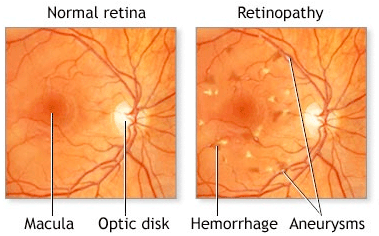Diabetic Retinopathy
 Diabetic retinopathy is damage to the retina caused by the complications of diabetes. These complications can potentially lead to blindness. This condition is the most common diabetic eye disease and a leading cause of blindness in American adults. Some diabetic eye diseases often have no early warning signs and can include a group of eye problems that people with diabetes may face. All can cause severe vision loss or even blindness. Some of the may include (1) Diabetic retinopathy, damage to the blood vessels in the retina (2) Cataracts, clouding of the eye's lens. Cataracts develop at an earlier age in people with diabetes and (3) Glaucoma, increase in fluid pressure inside the eye that leads to optic nerve damage and a loss of vision. A person with diabetes is twice more likely to get glaucoma than adults who do not have diabetes.
Diabetic retinopathy is damage to the retina caused by the complications of diabetes. These complications can potentially lead to blindness. This condition is the most common diabetic eye disease and a leading cause of blindness in American adults. Some diabetic eye diseases often have no early warning signs and can include a group of eye problems that people with diabetes may face. All can cause severe vision loss or even blindness. Some of the may include (1) Diabetic retinopathy, damage to the blood vessels in the retina (2) Cataracts, clouding of the eye's lens. Cataracts develop at an earlier age in people with diabetes and (3) Glaucoma, increase in fluid pressure inside the eye that leads to optic nerve damage and a loss of vision. A person with diabetes is twice more likely to get glaucoma than adults who do not have diabetes.
If you have diabetic retinopathy, at first, you may not notice some changes to your vision. But over time, diabetic retinopathy can get worse and cause blindness. The condition usually affects both eyes. According to the National Eye Institute (NEI) there are four stages of diabetic retinopathy. (1) Mild Nonproliferative Retinopathy. At this earliest stage, microaneurysms occur. They are small areas of balloon-like swelling in the retina's tiny blood vessels. (2) Moderate Nonproliferative Retinopathy. As the disease progresses, some blood vessels that nourish the retina are blocked. (3) Severe Nonproliferative Retinopathy. Many more blood vessels are blocked, depriving several areas of the retina with their blood supply. These areas of the retina send signals to the body to grow new blood vessels for nourishment. (4) Proliferative Retinopathy. At this advanced stage, the signals sent by the retina for nourishment trigger the growth of new blood vessels. This condition is called proliferative retinopathy. These new blood vessels are abnormal and fragile. They grow along the retina and along the surface of the clear, vitreous gel that fills the inside of the eye. By themselves, these blood vessels do not cause symptoms or vision loss. However, they have thin, fragile walls. If they leak blood, severe vision loss and even blindness can result.
Diabetic retinopathy is "an ocular manifestation of systemic disease which affects up to 80% of all patients who have had diabetes for 10 years or more. Research indicates that at least 90% of these new cases could be reduced if there was proper and vigilant treatment and monitoring of the eyes."
Diabetic retinopathy is detected during an eye examination. The examination should be conducted by an ocular physician or by an eye care professional and can include the following. (1) A visual acuity test using an eye chart to measure how well a patient sees for varied distances. (2) Pupil dilation, initiated by eye drops to widen the pupil allowing the physician to see more of the retina and look for signs of the condition. (3) Ophthalmoscopy, an examination of the retina done by examining the retina through a special magnifying lens and a brightly lit headset worn by the physician to gain a wider view of the retina. (4) Optical coherence tomography (OCT) - is high-tech optical imaging scans, which are used to measure the retina in fine detail. This allows the physician to observe any swelling or leaking. (5) Digital Retinal Screening Programs: These are methodical programs for the early detection of eye disease including diabetic retinopathy are becoming more and more common, predominantly in the UK, where all people with diabetes are offered retinal screenings annually. This involves digital image capture and transmission of the images to a digital reading center for evaluation and treatment referrals. See Vanderbilt Eye Institute and the English National Screening Programme for Diabetic Retinopathy. (6) Slit Lamp Biomicroscopy Retinal Screening Programs. These are also programs for the early detection of diabetic retinopathy using slit-lamp biomicroscopy.
If you have diabetes, comprehensive dilated eye exams are essential. Diabetic retinopathy can develop without symptoms. Macular edema can develop without symptoms at any of the four stages mentioned above. Macular edema is a disease fluid and protein deposits collect on or under the macula of the eye, a yellow central area of the retina, causing it to thicken, swell and ultimately lead to blindness.
Your physician can tell if you have macular edema or any stage of diabetic retinopathy. Whether or not you have symptoms, early detection and timely treatment can prevent vision loss. If you have diabetic retinopathy, you may need more regular eye exams. There are three major treatments for diabetic retinopathy, which are very effective in reducing vision loss from this disease. In fact, even people with advanced retinopathy have a 90 percent chance of keeping their vision when they get treatment before the retina is severely damaged. These three treatments are laser surgery, injection of triamcinolone into the eye and vitrectomy.
People with Diabetic retinopathy can reduce their risk of blindness by 95 percent with timely treatment and appropriate, consistent eye care.
For additional information or to schedule an Eye Examination, please contact us at (866) 611-7556.
Also Serving:
Sealy, TX - Bellville, TX - Columbus, TX - Katy, TX |
